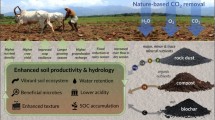Abstract
Eruptions from Ruapehu Volcano on 11 and 14 October 1995 and 17 June 1996 distributed at least 36×106 m3 of sulphur(S)-rich tephra over the central and eastern North Island of New Zealand. The tephras added between 30–1500 kg ha–1 S to at least 25 000 km2 of land in primary production. Smaller but beneficial amounts of selenium (Se) and in some areas potassium and magnesium were also supplied. Addition of S to the soils in the form of sulphate and elemental S resulted in a drop in soil pH and an increase in pasture S contents within seven weeks of the eruptions. The soils affected by the tephra are naturally low in S and Se, but following the eruptions S was not required in fertilizer applications in many areas. The strongest and longest lasting effects of S and Se deposition were in high anion-retention soils particularly Hapludands (moist, moderately weathered soils, derived from volcanic ash). Soluble fluorine concentrations within the tephras were low compared to historic Icelandic and Chilean examples. However, pastoral livestock deaths were apparently caused by fluorosis in addition to starvation when tephra covered feed. The Ruapehu tephra contained very low concentrations of other soluble toxic elements.
Similar content being viewed by others
Author information
Authors and Affiliations
Additional information
Received: 17 January 1997 · Accepted: 31 March 1997
Rights and permissions
About this article
Cite this article
Cronin, S., Hedley, M., Neall, V. et al. Agronomic impact of tephra fallout from the 1995 and 1996 Ruapehu Volcano eruptions, New Zealand. Environmental Geology 34, 21–30 (1998). https://doi.org/10.1007/s002540050253
Issue Date:
DOI: https://doi.org/10.1007/s002540050253




